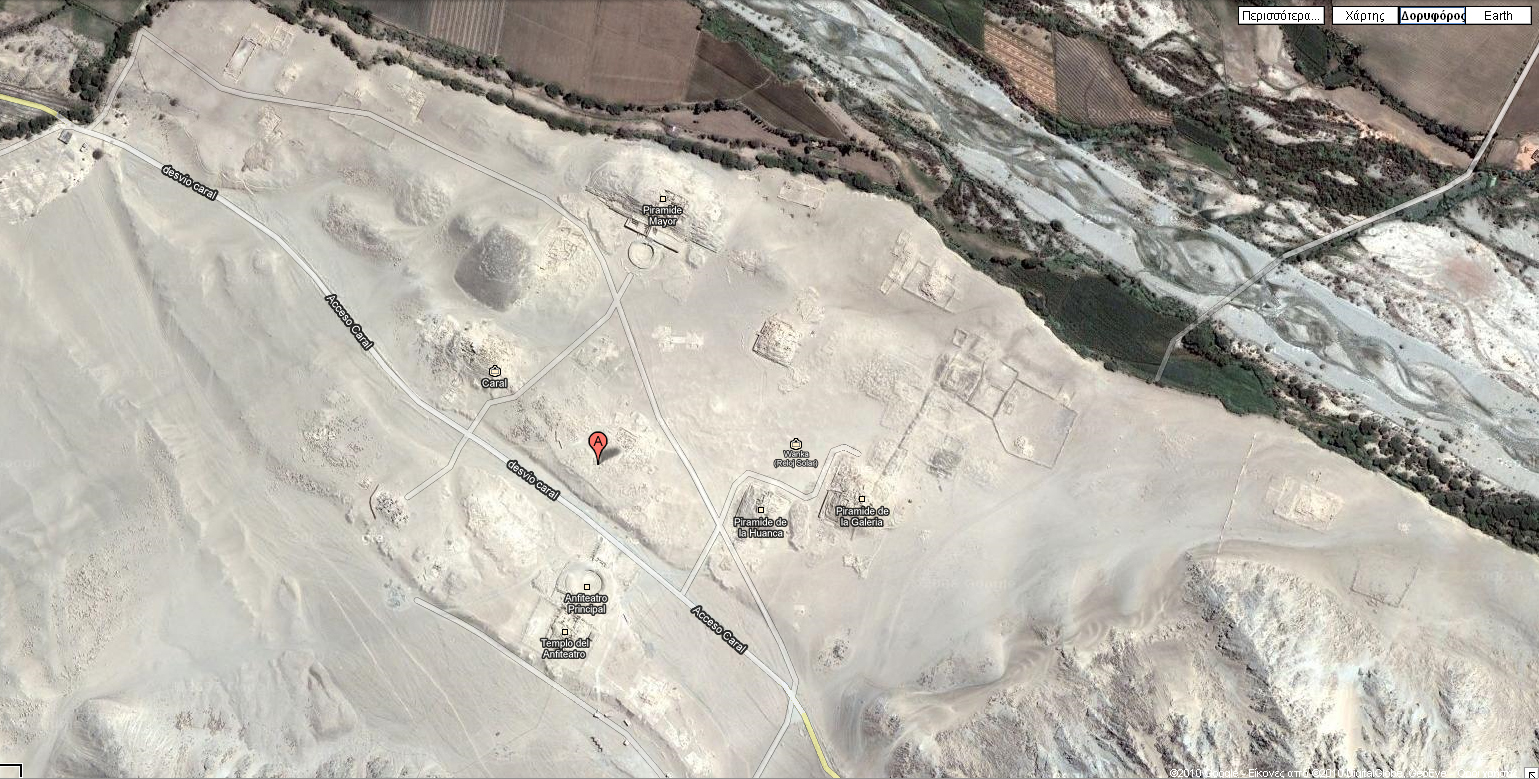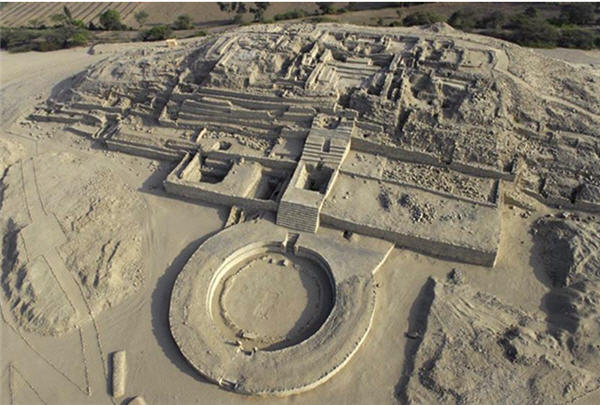
Caral city plan based on
the so far excavations
source: http://www.freerepublic.c
om/focus/f-news/1724450/p
osts (accessed :
01-10-2010)

the archaeological site
of Caral city as it can
be seen on google maps
source: http://maps.google.com/
(accessed : 01-10-2010)

sunken plaza with
amphitheater in Caral
city
source: http://www.peruviantimes.
com/history-of-peru-serie
s-part-1-the-dawn-of-urba
nization/236447 (accessed
: 01-10-2010)
|
Caral, the center of the Caral-Supe civilization (or Norte-Chico) in Peru got into the limelight in 2001 when the journal Science announced that urban life occurred in the New World around 3000 BCE. Caral is one of the 18 urban settlements situated in the Supe valley in Peru. While the oldest city of Norte-Chico seems to be Huaricanga which existed around 3500 BCE, Caral with its 626 hectare site was called 'The Mother City of the Americas' by the archaeologist Dr Ruth Shady Solis of the Universidad Nacional Mayor de San Marcos in Peru. For thousands of years, our ancestors used to live in tribes, or villages, so the archaeologists in order to distinguish the first moment where humans in a region decided to bond together in an urban settlement, they use the notion 'The Mother City'.
Based on the so far findings, there is the belief that around 2700 BCE many small villages due to their success in agriculture and fishing united, resulting in the creation of the Norte-Chico civilization. Caral, however, has concentrated the media interest since 2001 because it reveals 'the emergence of the first complex society in the New World'. 1 The whole archaeological site of the Sacred City of Caral is, according to Unesco, 626.3600 ha. 2 What is impressive though, is that the core of the site, which covers an area of 150 acres, consists of six mounds-pyramids, two sunken plazas and a large plaza in the middle connecting all the previous structures. The monumentality of these buildings and the planning of the city show, according to archaeologists, that a new socio-political model had emerged. Irrigation canals and cotton fishing nets are some of the findings that show a possible food surplus which might have resulted in a complex economic model of trade creating a strong, wealthy society with big labor force. According to Dr Haas, 'This site just consumed labor,' [..] 'There's a surplus at these sites," Dr. Haas said, "and it's not going into storage of foodstuffs. It's going into construction." 3
The scale and the functions of the core of the site indicate a concentration of religious, administrative and political power. As Jonathan Haas of the Field Museum in Chicago, US, said, "The size of structure is really an indication of power" and continued denoting that "It means that leaders of the society were able to get their followers to do lots of work". 4 While getting people to work so hard could have a dictatorial connotation, it seems that in Caral, they had a very different way to motivate workers : Haas and Creamer believe that the city rulers encouraged the workforce during construction by staging celebratory roasts of fish and achira root.[...] Alcohol is suspected of having been consumed, and music seems to have been played...5 From the excavations, so far, it is evident that the city was inhabited by approximately 3000 inhabitants, but the residential complexes are situated in different parts according to the social classes to which they addressed : elite high-quality housing close to the pyramids while low quality ones further from the core. Zoning was a key element in the planning of the city manifesting hierarchy in power and social stratification. Caral seems to have had a state government with a centralized authority, complex social organization and division of labor.
While the city was perfectly planned, its location wasn't strategic and the lack of defensive walls or battlements shows that there was no warfare. The historian John Reader in his book 'Cities' mentions the so far belief that the reason why people came together creating cities was for defensive reasons, something that seems entirely unlikely to have happened in Caral. This gentle and peaceful society had possibly based its function on co-operation for the benefit of the individual and the community as a whole.
Around 2000 BCE Caral was abandoned. The reason remains unknown, but what is more accepted is that there was a drought forcing the inhabitants to move and settle in more fertile sites. According to Professor Winifred Creamer, an anthropologist at Northern Illinois University, "You can use irrigation to explain both the rise and fall of the Norte Chico region. By 1,800 B.C., when this civilization is in decline, we begin to find extensive canals farther north. People were moving to more fertile ground and taking their knowledge of irrigation with them. The Norte Chico ultimately became something of a frontier zone between northern and southern centers of influence and political development." 6
The importance of Caral does not lie only in the fact that civilization emerged 1000 years earlier in the New World than they had believed so far. Caral city is deemed to be 'a true cradle of civilization' with a strong impact on Andean ones for about four millennia. Elements of its urban design, like the central plaza, but also of its socio-political structure are found later in Chavin, Moche, Wari, Chimu and Inca's settlements. As Haas asserts, 'The cultural pattern that emerged in this small area in the third millennium B.C. later established a foundation for 4,000 years of cultural florescence in other parts of the Andes'. 7
NOTES :
1. BBC [British Broadcasting Corporation] News Online, 'Oldest City in the Americas', Thursday, 26 April, 19:12 GMT. Online available from : http://news.bbc.co.uk/2/hi/science/nature/1298460.stm (accessed : 1st October 2010)
2. UNESCO [United Nations, Educational, Scientific and Cultural Organization] World Heritage, [online], 'Sacred City of Caral-Supe'. Online available from : http://whc.unesco.org/en/list/1269 (accessed : 1st October 2010)
3. Henry Fountain, 'Archaeological site in Peru is called Oldest City in Americas', The New York Times [online], April 27, 2001. Online available from : http://www.nytimes.com/2001/04/27/world/archaeological-site-in-peru-is-called-oldest-city-in-americas.html (accessed : 1st October 2010)
4. BBC [British Broadcasting Corporation] News Online, 'Oldest City in the Americas', Thursday, 26 April, 19:12 GMT. Online available from : http://news.bbc.co.uk/2/hi/science/nature/1298460.stm (accessed : 1st October 2010)
5. Philip Coppens, 'Caral : The oldest town in the New World', first appeared in Frontier Magazine 8.3, May 2002. Online available from : http://www.philipcoppens.com/caral.html (accessed : 1st October 2010)
6. Simon Hooper, 'New Insight into Ancient Americans', CNN [Cable News Network] News Online, International Edition, Tuesday, 4 January, 2005, posted 11:26 GMT. Online available from : http://edition.cnn.com/2005/TECH/science/01/04/norte.chico/ (accessed : 1st October 2010)
7. Simon Hooper, 'New Insight into Ancient Americans', CNN [Cable News Network] News Online, International Edition, Tuesday, 4 January, 2005, posted 11:26 GMT. Online available from : http://edition.cnn.com/2005/TECH/science/01/04/norte.chico/ (accessed : 1st October 2010)
source: 1. BBC [British Broadcasting Corporation] News Online, 'Oldest City in the Americas', Thursday, 26 April, 19:12 GMT. Online available from : http://news.bbc.co.uk/2/hi/science/nature/1298460.stm (accessed : 1st October 2010)
2. Creamer W., Haas J. and Ruiz A., "Archaeologists shed new light on America's earliest known civilization", NIU [Northern Illinois University] News Release, 22 December, 2004. Online available from : http://www.niu.edu/pubaffairs/presskits/peru/release.html (accessed : 1st October 2010)
3. Dr Ruth Shady Solis (2001) Telephone interview with Rick Pettigrew (president and executive director of Archaeological Legacy Institute) for The Archaeology Channel, 30 July, 2001. Online available from : http://www.archaeologychannel.org/caralint.html (accessed : 1st October 2010)
4. Henry Fountain, 'Archaeological site in Peru is called Oldest City in Americas', The New York Times [online], April 27, 2001. Online available from : http://www.nytimes.com/2001/04/27/world/archaeological-site-in-peru-is-called-oldest-city-in-americas.html (accessed : 1st October 2010)
5. Paul Goulder, 'History of Peru series part 1 : The dawn of urbanization', Andean Air Mail and Peruvian Times, [online], 23 June, 2010. Online available from : http://www.peruviantimes.com/history-of-peru-series-part-1-the-dawn-of-urbanization/236447 (accessed : 1st October 2010)
6. Philip Coppens, 'Caral : The oldest town in the New World', first appeared in Frontier Magazine 8.3, May 2002. Online available from : http://www.philipcoppens.com/caral.html (accessed : 1st October 2010)
7. Simon Hooper, 'New Insight into Ancient Americans', CNN [Cable News Network] News Online, International Edition, Tuesday, 4 January, 2005, posted 11:26 GMT. Online available from : http://edition.cnn.com/2005/TECH/science/01/04/norte.chico/ (accessed : 1st October 2010)
8. Tony Dunnell, 'The Pyramids of Caral, Peru : Ancient Peru sites of the Norte Chico & Oldest City of the Americas', [online], 8 February, 2010. Online available from : http://www.suite101.com/content/the-pyramids-of-caral-peru-a199555 (accessed : 1st October 2010)
9. UNESCO [United Nations, Educational, Scientific and Cultural Organization] World Heritage, [online], 'Sacred City of Caral-Supe'. Online available from : http://whc.unesco.org/en/list/1269 (accessed : 1st October 2010)
10. Wikipedia, vocabulary entry : Caral (accessed : 1st October 2010)
11. Wiki Sumaq Per?ɬ? , vocaulary entry : Caral-Supe (accessed : 1st October 2010) |

